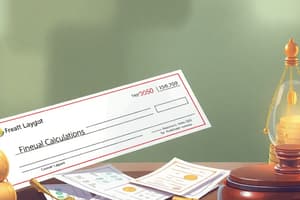Podcast
Questions and Answers
What is the primary purpose of 'account payee' crossing on a cheque?
What is the primary purpose of 'account payee' crossing on a cheque?
- To ensure the cheque can only be encashed by the recipient
- To allow the cheque to be negotiated freely
- To restrict the negotiability of the cheque to a specified account (correct)
- To indicate that the cheque is invalid
In what way does a cheque with 'not negotiable' crossing differ from a standard cheque?
In what way does a cheque with 'not negotiable' crossing differ from a standard cheque?
- It can only be cashed by the cheque holder
- The cheque holder retains transferor status but cannot negotiate it (correct)
- It can be freely negotiated like a regular cheque
- It cannot be transferred at all
When a cheque has 'restrictive crossing,' what instruction does it provide to the receiving banker?
When a cheque has 'restrictive crossing,' what instruction does it provide to the receiving banker?
- To credit the cheque amount to a specified account only (correct)
- To reject the cheque altogether
- To allow free negotiation of the cheque
- To convert the cheque value into cash
What happens if an assembling banker ignores the guidelines of 'restrictive crossing' on a cheque?
What happens if an assembling banker ignores the guidelines of 'restrictive crossing' on a cheque?
How does 'general crossing' impact the negotiability of a cheque?
How does 'general crossing' impact the negotiability of a cheque?
What is the key characteristic of a bearer cheque?
What is the key characteristic of a bearer cheque?
How does an order cheque differ from a bearer cheque?
How does an order cheque differ from a bearer cheque?
What makes a post-dated cheque unique compared to other types of cheques?
What makes a post-dated cheque unique compared to other types of cheques?
What happens if a bank charges fees for cashing a stale cheque?
What happens if a bank charges fees for cashing a stale cheque?
How does a crossed cheque impact the recipient's ability to access funds?
How does a crossed cheque impact the recipient's ability to access funds?
Flashcards are hidden until you start studying
Study Notes
Crossing of Cheques
Cheque crossing refers to the process where a cheque is marked with specific instructions on how it should be handled by a bank. These markings ensure that the cheque follows legal guidelines and provides protection against fraudulent activities. There are several types of cheque crossing, each with unique characteristics and purposes.
Special Crossing
Special crossing involves adding the name of the banker to the cheque, either with or without the phrase "not negotiable." This type of crossing allows the paying banker to honor the cheque only if it is presented to the bank whose name appears in the crossing or to its associated branch. Special crossings do not require the presence of the two parallel lines found in general crossings.
General Crossing
General crossing adds the words "and company" or similar phrases between two parallel lines drawn diagonally across the cheque. These lines indicate that the cheque can be honored only by the bank on which it is drawn and not by other banks. The presence of these lines prevents the cheque from being cashed directly at the counter of the bank, ensuring that the funds are deposited into a bank account instead.
Not Negotiable Crossing
A not negotiable crossing occurs when the phrase "not negotiable" is written between the two parallel lines on the cheque. This type of crossing removes the ability of the transferee to acquire a better title than the transferor. Such a crossed cheque can still be transferred but cannot be negotiated, meaning the cheque holder maintains the status of a transferor.
Account Payee Crossing
When the phrase "account payee" or similar expressions are drawn diagonally across the cheque, it indicates that the recipient's account is the only place where the funds can be transferred. This type of crossing ensures that the money moves into a bank account and not in the form of cash.
Restrictive Crossing
Restrictive crossing limits the negotiability of the cheque by instructing the receiving banker to credit the value of the cheque to the specified account. When the assembling banker fails to comply with these guidelines, they may be held responsible for any damages incurred.
In summary, cheque crossing serves as a vital mechanism for securing transactions and preventing potential fraud. Each type of crossing carries specific instructions to guide bankers on how to handle the cheque, ensuring that the intended recipient receives the funds according to the desired terms.
Studying That Suits You
Use AI to generate personalized quizzes and flashcards to suit your learning preferences.




